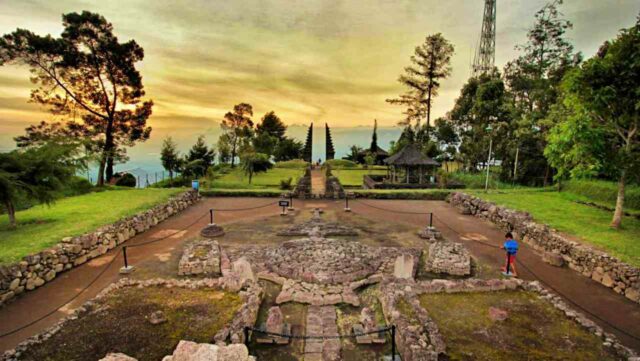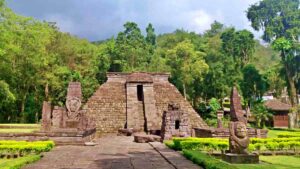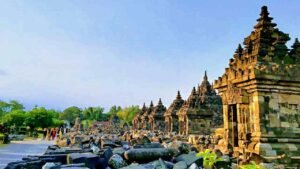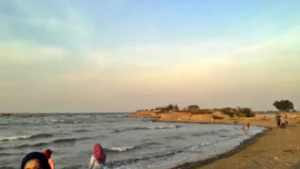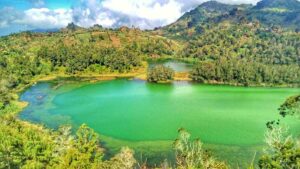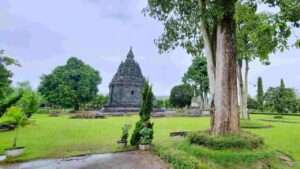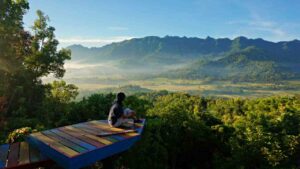Cetho Temple or Candi Ceto is famous as a realm above the cloud. Located on a mountain slope, this heirdom is the highest temple in Indonesia. From 1496 AMSL high, anyone can see a solid, beautiful natural overall view. Including the majestic Mount Merbabu to the active volcanic Mount Merapi scenery. Carry an extra outer because the weather can be pretty cold up there!
To find the cultural heritage, head to Cetho hamlet in Karanganyar regency. It is located about 7 kilometers away in the west of Mount Lawu. Being hillside, Candi Ceto opens tracking access for the mountain’s climbers. It might take a detour and require a longer time to the top. Yet, most climbers prefer taking this way for the beauty that compares to nowhere.
There is something unique to notice about guests’ attire in the temple. All people seem to wear the same white and black plead sarong. That is due to the regulations that everyone should keep the place chaste. But, keep the worries away because the officials rent it for visitors. On the bright side, it’s more of a donation than a rental fee. Visitors can pay any amount willingly without a fixed price.
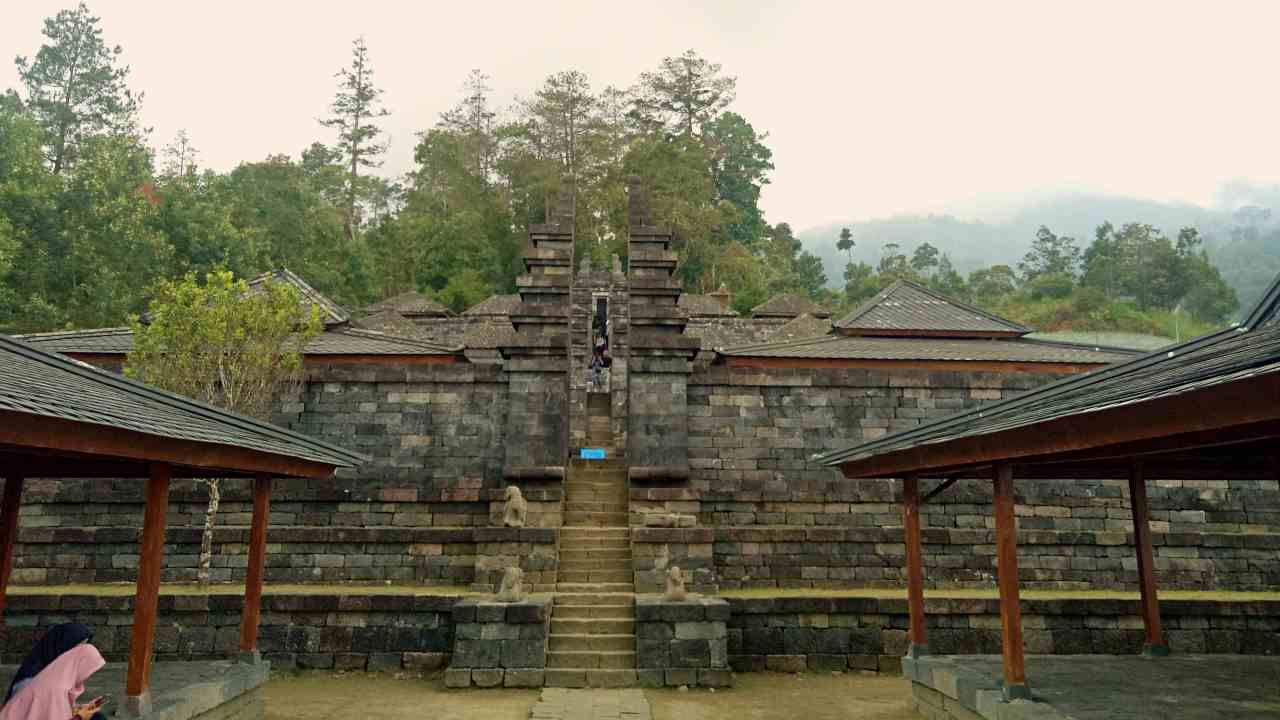
Cetho Temple Entrance Fee
Candi Cetho’s admission ticket is 10 times cheaper than the Prambanan temple ticket. International tourists will be charged Rp30.000 only for the entrance fee.
| Cetho Temple Entrance Fee | |
| Ticket | Rp30.000 |
See: Guide To Mendut Temple & Monastery, Magelang.
Cetho Temple Opening Hours
The temple, on regular basis, opens from 8 AM to 5 PM every day (except Nyepi Day). To enjoy the chilly air, come in the early morning or late afternoon. The place should not be too crowded as well around the time.
| Cetho Temple Opening Hours | |
| Every day | 08:00 – 17:00 |
Nearby: Candi Sukuh, Cleansing Temple & Wishing Waterhole.
Learning Cetho Temple History
Find a lot more about Cetho Temple other than its grandeur through history. Because there is an interesting tale that awaits anyone who wishes to know. Many believe that this temple remains from Majapahit Kingdom’s era. It served as a place for what Javanese called ruwatan. Meaning an act of purification from any kind of curse. All of that is according to an engraved relief, Sudamala, on the eight terraces.
Wanting to preserve the site, governments made significant restoration in 1970. It was several decades after Van der Vlis found it in 1842. However, the major renovation received criticism from archeologists. Claiming that the process changed too much of its original structures. However, do not worry because this temple still keeps so much from authentic discovery as well as sacred and historical as it is supposed to be.
The remaining history is easy to find through the information board. Everyone can easily spot it upon entrance. Those who wish to learn more can hire local guides around. The locals are more than happy to help with additional fees apply. However, kindly be understanding of the slight language barrier that may happen.
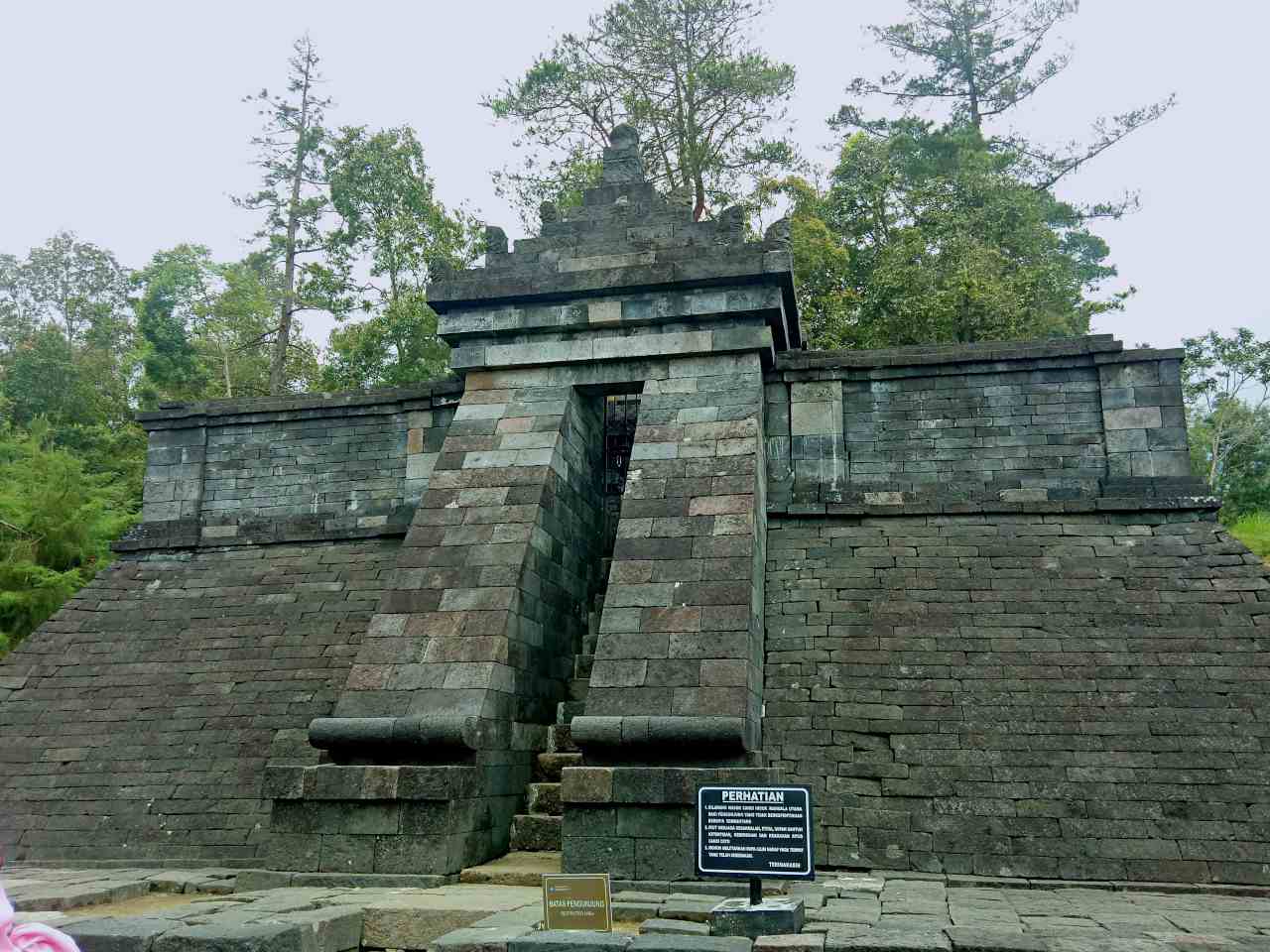
Sightseeing at Cetho Temple
Looking from afar, the temple may resemble an architectural concept from Candi Borobudur. Which is the biggest Buddhist temple in Indonesia. It’s obvious from the similar terraces concept or punden berundak as Indonesian know. Yet closely, anyone will sense the temple possesses a strong Balinese temple characteristic. It’s fascinating that one temple could represent two beliefs at once.
Cetho Temple stretches from east to west with eleven stacked platforms. Climb up the stairs to explore each feature of the platforms. Starting from statues, reliefs, and buildings made for purification or meditation. On top of the structure, there lies a chamber secluded on a stone wall. Dedicated to Prabu Brawijaya, the king who built Candi Ceto.
The splendor of Cetho Temple does not exist only in the main structure. Upon entrance, a beautiful garden welcomes with prominent rock arrangements in the center. Take some time to stay in the area to study the details. And do not miss the chance to take an iconic picture at the gate. The tip is to stand between the gate facing the temple. That way, the picture will catch a high sky view as a background.
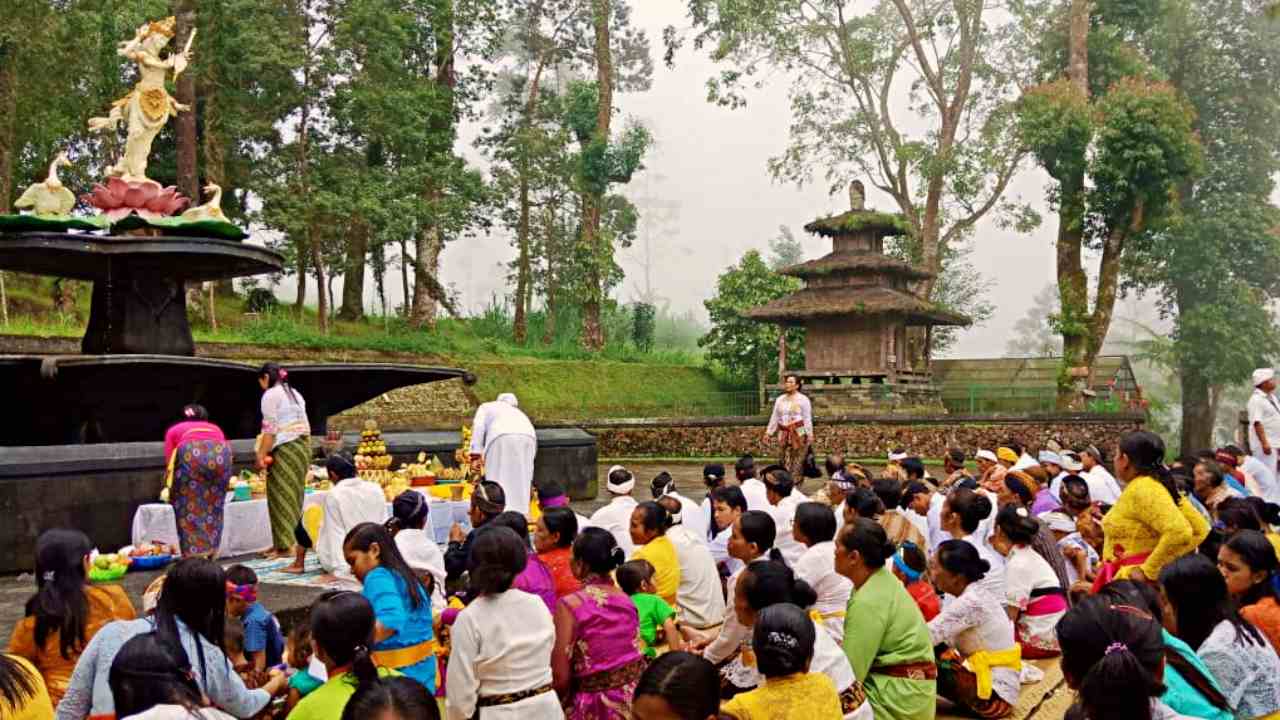
Witness Locals’ Religious Rituals
Entering the temple, everyone will feel nothing but mystical air surrounding the hill. That should be no surprise because the temple serves as a worship place. On daily basis, it is common to see Hindunese locals doing daily rituals. Even Javanese people who hold onto Kejawen beliefs still come here to meditate. Therefore, pay some respect to the locals by not being loud inside.
If lucky, visitors could witness the entire ceremony procession from the beginning to the end. First off, pick the closest important Hindu dates on the internet from the itinerary. The most common ones are Galungan and Kuningan. However, avoid coming to the place in Nyepi. Because Candi Cetho is not open to the public on that important day.
On a side notice, women on period are not allowed to enter the temple. Remembering that everyone should keep holiness. To pay respect to the ancestors, be mindful when uttering words. Choose only kind and respectful words instead of impolite ones. And most definitely, keep the place clean by throwing trashes only in the designated place. It is not hard at all to find trash cans in the area.
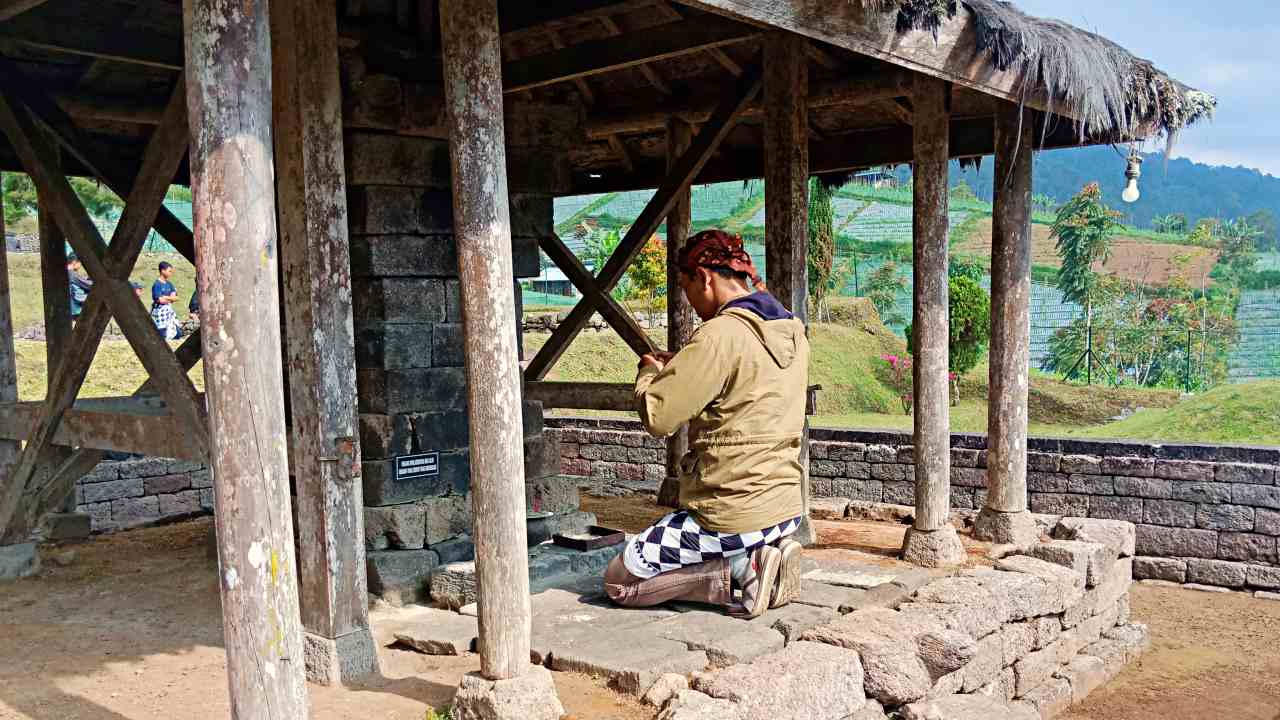
Photo Hunting
Catch everything Cetho Temple has to offer through pictures. From above the temple, it is practically easy to snap various sceneries. Each side of the temple has its own charms. Facing toward the south, see the back of majestic Mount Lawu and its slopes. To enjoy the view of plantations, just slide to the western side. And to get a city view from above, simply go towards the northern angle.
The different sceneries show how abundant the natural gifts that Cetho Temple hides. Therefore, a camera person would love so much to stay around longer. Unless the weather is not friendly this creates a thick fog around. Because Cetho Temple’s visibility indeed depends heavily on the weather. Therefore, make sure to check the forecast regularly to meet the bright weather.
The officials strictly prohibit drone use unless with valid permission. That should come from Central Java’s Institute for Preservation of Cultural Heritage (BPCB) and the police station. It is better to administer everything one day prior to avoid rushing time. Also, make time to call the BPCB office first to ask for the current permit regulations.
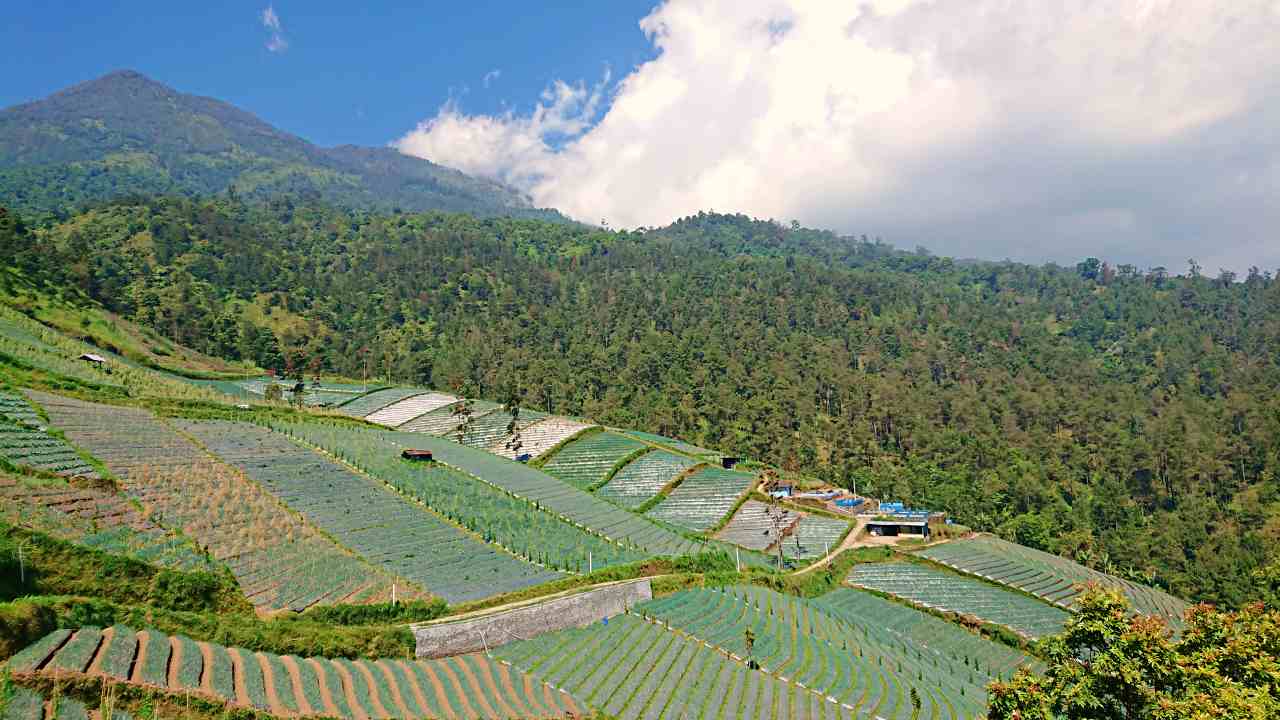
Catching Sunset
In Javanese, cetho has a meaning of vivid or clear. And from that word, Cetho Temple’s name emerged. Interpreting the meaning of the temple’s characteristics is not hard at all. It simply tells that from this temple, everyone can see everything clearly. Starting from the city, the houses, the plantations, and the grand mountains. All that included a beautiful sunset.
However, not everyone can get lucky enough to catch the sunset from above. Due to its operational hours, visitors have to leave at 5 PM at the latest. Meanwhile, the sun usually sets near 6 PM which is impossible. But, try asking if there is a possibility for special permission upon arrival. Some people already got lucky and managed to stay and wait for the sunset.
Another option is to climb down the temple but stay outside the area. Being in a highland, it is not a problem to seek sunset in whichever spot. There are public spaces to visit that open after the temple closes. Spare some time to stay and wait for the sunset to begin its showcase.
See: Guide To Explore Bromo Volcano Crater & National Park.
Facilities
Climbing the nine platforms up and down might be tiring for some people. Therefore, on the exit, visitors can stop by to buy drinks and snacks. The choice varies from instant noodles to fried snacks with a range from Rp1.000. Which is very cheap and worth buying as an energy booster.
As a tourist site, it comes normally to find toilets in the area. A prayer room is available for Muslims to pray. Considering that many local travelers also visit this place. At last, before leaving the area, visit the souvenir shops to bring some memories back home. Therefore, there is always a reason to remember Cetho Temple anytime, anywhere.
A parking lot is also available near the entrance for both cars and motorbikes. Cars should pay Rp10.000 for one parking ticket. Meanwhile, it costs Rp3.000 for motorbikes. Also, here is some friendly caution for incoming visitors. It might be a short distance from the gate. But, be ready to hike up a very steep paved hill. Just buy some drinks outside along the way to help freshen up.
See: Kawah Ijen Guide & How To Get To Ijen Crater.
How To Get To Cetho Temple
The closest city to Cetho Temple is no other than Solo or Surakarta. It takes about a 1-hour drive if the traffic is normal. Despite the distance, it might be convenient to rent a car with a driver. Considering the steep road that is not friendly at all for highland amateurs. The price usually starts from Rp200.000/day depending on the car type.
The second option is to use a ride-hail app which is easier, although not cheaper. It costs about Rp210,000 per one-way to Cetho Temple. Kindly consider that it is not easy to find the ride back uphill. Although, there are online drivers to book around the area.
When public transportation is an option, travelers can use a bus to the nearest station. Let’s say that the departing point is from Slamet Riyadi. An area in Solo where travelers usually stay. From there, find the Tirtonadi bus station and choose a bus that goes to Tawangmangu. Then, make a stop at Karangpandan station to take another shuttle.
The journey does not stop at Karangpandan station. From there, take a public van that heads to Kemuning station. Which are only 20 minute’s drive away from Cetho Temple. To get closer, use local or online transportation from there. It should take around Rp16.000 for a motorbike and Rp26.000 for a car.
See: SIM Card Price in Indonesia, Data Package & Provider.
Address & Location
Candi Cetho is situated in a village called Gumeng, Jenawi district, Karanganyar, Central Java 57792.

